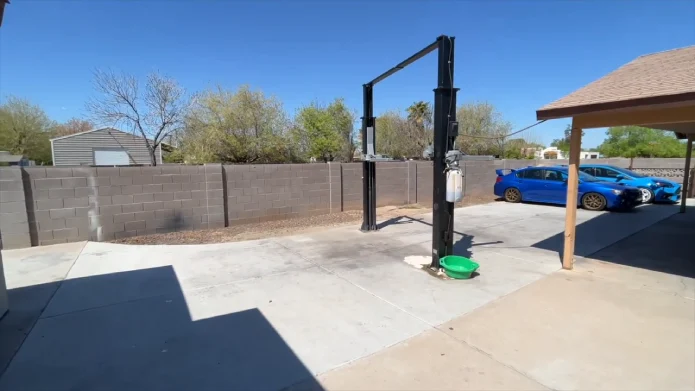Last Updated on May 29, 2023
If you’re considering installing a car lift, you might be wondering if you can install it outside. While it may be tempting to save space in your garage or workshop, installing a car lift outside comes with its own set of challenges.
An outdoor environment exposes your car lift to various weather elements, including rain, snow, and harsh sunlight. These elements can cause damage to the lift’s components and reduce its lifespan.
Also, an outdoor environment may lack the necessary electrical and structural requirements for a car lift installation.
So, if you’re thinking about installing a car lift outdoors, hold up. Let’s explore why this might not be the best move.
Why Installing a Car Lift Outside is Not a Good Idea?
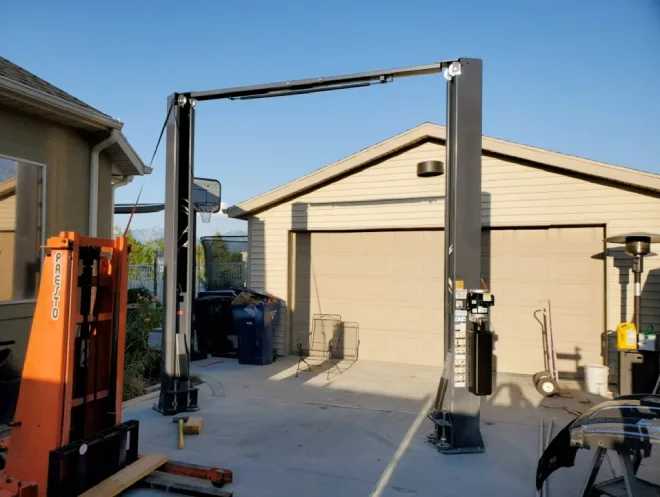
If you’re planning to install a car lift outside, consider several key factors. These are:
1. Weather Damage
It is not recommended to install a car lift outside due to the constant exposure to the elements. Rust, corrosion, and other forms of damage can occur, leading to costly repairs and maintenance.
Outdoor lifts will be exposed to harsh winds, rain, and snow year-round, accelerating the wear and tear on the equipment.
Also, prolonged exposure to sunlight can cause damage to hydraulic fluids and hoses, leading to a loss of lifting power and increased susceptibility to leaks.
2. Safety
Safety is a significant concern when it comes to installing car lifts outside. Outdoor lifts are more prone to accidents such as falling debris, animals, and vandalism.
Even small debris can damage the lift, causing it to malfunction and threaten vehicle safety. Animals such as birds can nest on the lifts, leaving droppings that can corrode and damage the equipment.
Also, vandals can easily access outdoor installations that can harm the lift or the vehicle being lifted, putting them at risk of injury. To ensure the safety of the equipment and vehicles being lifted, it is highly recommended to install car lifts indoors.
3. Maintenance
Maintaining outdoor car lifts can be more challenging than indoor installations due to exposure to environmental factors such as weather, debris, and other outdoor elements.
Outdoor lifts may require more frequent maintenance than indoor lifts, increasing maintenance costs. Neglected outdoor lifts can lead to significant breakdowns, causing service delays, lost revenue, and customer dissatisfaction.
4. Security
Security is a crucial factor to consider when installing a car lift outdoors. Outdoor installations are less secure than indoor installations, making them more vulnerable to theft or tampering.
Criminals can quickly gain access to outdoor lifts, stealing or damaging expensive equipment and damaging vehicles being lifted.
Investing in good quality security equipment for outdoor lifts can be costly and requires ongoing maintenance, adding to maintenance costs.
Installing car lifts in secure indoor environments is recommended to protect against theft and ensure customer safety.
5. Accessibility
Accessibility is a significant issue for outdoor car lift installations as they may not be accessible during inclement weather or other adverse conditions.
During harsh weather conditions such as snow, ice, or heavy rainfall, outdoor lifts could become dangerous to operate, and car owners may not be able to use their vehicles.
It can lead to unhappy customers and delayed maintenance schedules. In contrast, indoor installations ensure that car lifts are always accessible to both customers and mechanics, regardless of weather conditions.
6. Permitting
Permitting is another significant issue to consider when installing car lifts outside. Installing a car lift on the outside may require permits or approvals from local authorities, which can be a time-consuming and expensive process.
Failure to obtain the necessary permits can lead to fines or even legal repercussions. To avoid these issues, it is crucial to ensure that all permits and approvals are obtained before installing outdoor lifts.
Indoor installations can simplify permitting, often requiring fewer permits and approvals.
How Do You Prepare The Installation Site for an Outdoor Car Lift?
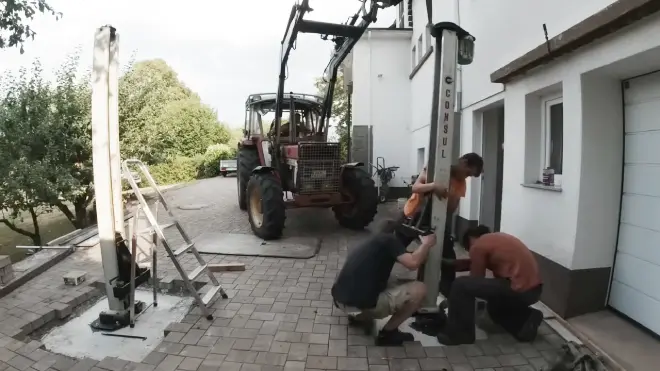
If you decide to install your car lift outside, despite knowing the potential drawbacks, you must consider certain factors.
Preparing the site for an outdoor car lift requires careful attention to leveling, foundation, drainage, and lighting, ensuring a secure and reliable setup that’ll make your heart sing with confidence.
Step 1: Ensure the site is level and compact by removing any rocks, debris, or vegetation. Then, create a solid foundation by pouring a reinforced concrete slab at least four inches thick with a minimum compressive strength of 3,000 psi.
This will provide a stable base for the lift and prevent it from sinking or shifting over time.
Step 2: Provide proper drainage by grading the site away from the lift and installing a catch basin to channel water away from the area. As a result, the lift will not be damaged by water and the site will be kept dry and safe.
Step 3: Install appropriate lighting to illuminate the lift area and prevent accidents or injuries. With these measures in place, you can rest assured that your outdoor car lift will be installed on a solid and secure foundation.
Step 4: As you prepare to install your car lift outside, it’s important also to consider the safety measures that need to be observed. These precautions help prevent accidents and ensure the lift remains in good working condition.
What are the safety measures to observe when installing a car lift outside?
Proper grounding, weather-resistant materials, sufficient clearance, and secure anchoring are essential for a safe and reliable outdoor lift setup.
When grounding, it’s important to connect the lift’s electrical components to a ground rod or a building’s grounding system to prevent electrical shock or damage to the lift’s motor.
Regarding weather-resistant materials, use coatings or paints that are resistant to rust and corrosion. The lift’s hydraulic components should also be protected from extreme temperatures, which can affect its performance.
Providing sufficient clearance around the lift is crucial for safe operation. This means ensuring enough space for the lift to move up and down without hitting anything.
Also, securing the lift to prevent tipping over is crucial for safety. Anchoring the lift to a concrete pad or foundation, or using a heavy-duty stand to support the lift’s weight, can help prevent accidents.
What are the maintenance requirements for an outdoor car lift?
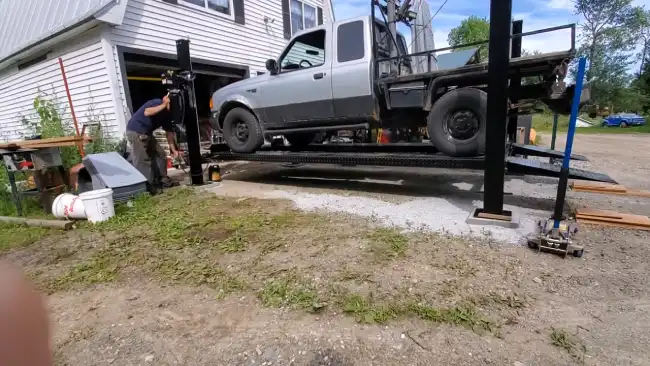
Maintaining an outdoor car lift requires regular attention to ensure optimal functionality and safety.
You should regularly clean and inspect the lift, paying special attention to the moving parts. Lubricating these parts is also essential to ensure smooth operation and prevent premature wear and tear.
Outdoor lifts are exposed to weather elements, which can cause damage and reduce their lifespan. Therefore, it’s crucial to protect the lift from excessive sun, rain, and snow by installing a durable cover or shelter.
Inspect the lift frequently for signs of damage and replace any damaged parts immediately to avoid accidents. Ensuring that your outdoor car lift is properly maintained will help you avoid costly repairs and ensure safe and efficient operation.
Can a car lift be used in rainy or snowy conditions?
Using a lift in rainy or snowy conditions requires extra safety precautions and attention to potential hazards.
It’s important to ensure that the lift is installed and maintained properly, as any electrical or mechanical components that aren’t in good condition could be more susceptible to damage or malfunction in wet or snowy conditions.
Wet or snowy conditions can create slippery surfaces, increasing the risk of slips, falls, or accidents. As a result, it may be necessary to take extra safety precautions, such as wearing appropriate footwear or providing additional lighting in the area.
The safety of the operator and anyone else working in the area should always be a top priority when using a car lift in rainy or snowy conditions.
How long is the life expectancy of a vehicle lift?
A properly maintained 2-post or 4-post lift can last several decades. It is not uncommon to find used lifts for sale that are 20, 30, or even 40 years old.
With regular maintenance and inspections, a lift can continue to operate safely and efficiently for many years.
The lifespan of a lift ultimately depends on various factors, such as usage frequency, condition of the components, and compliance with safety regulations.
To ensure the longevity of your lift, it is essential to follow manufacturer recommendations, perform routine maintenance, and address any issues promptly.
Ultimately, investing in a high-quality lift and maintaining it properly can provide reliable service for a significant period, making it a valuable asset for any automotive or industrial facility.
How do you find a quality car lift that will last long?
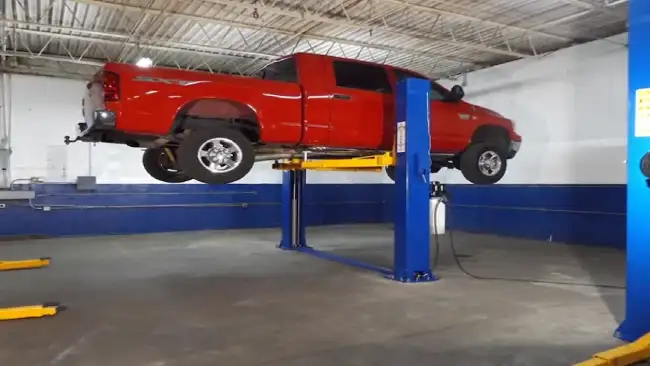
You can rely on reviews and recommendations to purchase a long-lasting car lift. One effective approach is to check our review, where we have already evaluated and assessed several good-quality car lifts for home garages.
Our comprehensive assessments consider building quality, safety features, lifting capacity, ease of use, and customer feedback.
By relying on our review of top-rated car lifts for home garage, you can make an informed decision to select a high-quality car lift that will provide reliable performance for your needs.
Where should a car lift be placed in a garage?
When positioning a car lift, the general rule of thumb is to align it with the entry door or bay. This ensures easy vehicle access and maximizes the garage’s overall functionality. You can choose where to place the lift if you have a larger garage space.
How far should the 2-post car lift be from the side wall?
It is generally recommended to create adequate space around 2-post car lifts and hoisted vehicles by positioning them at least two feet away from side walls.
This space allows for easier movement around the vehicle and for the arms of the lift to fully extend without hitting the wall.
The two feet of clearance also provide some safety benefits. If a vehicle slips off the lift, the extra space can prevent damage to the walls or other equipment in the garage.
It’s important to keep this in mind when planning the layout of your garage or workspace to ensure that the lift is placed in a location that allows for proper clearance on all sides.
Avoid to Install Car Lift Outside for Your Vehicle Maintenance
While the idea of installing a car lift outside your home or workshop may seem appealing, you should consider all the potential risks and drawbacks. From safety concerns to maintenance requirements and environmental hazards, outdoor lifts have their challenges.
Instead, invest in a high-quality indoor car lift and follow proper installation and upkeep procedures to extend the life and safety of your vehicles. With the convenience and versatility of an indoor car lift, you can easily access and work on your automobiles. This is without worrying about weather conditions, theft, or other external factors.
